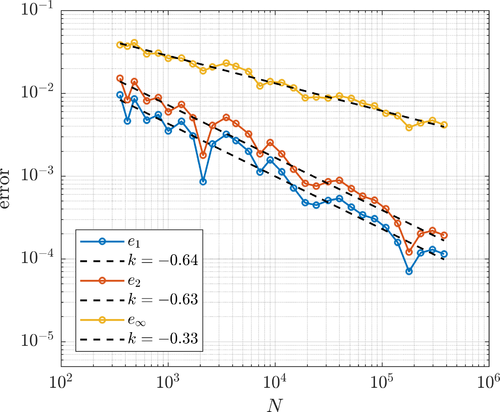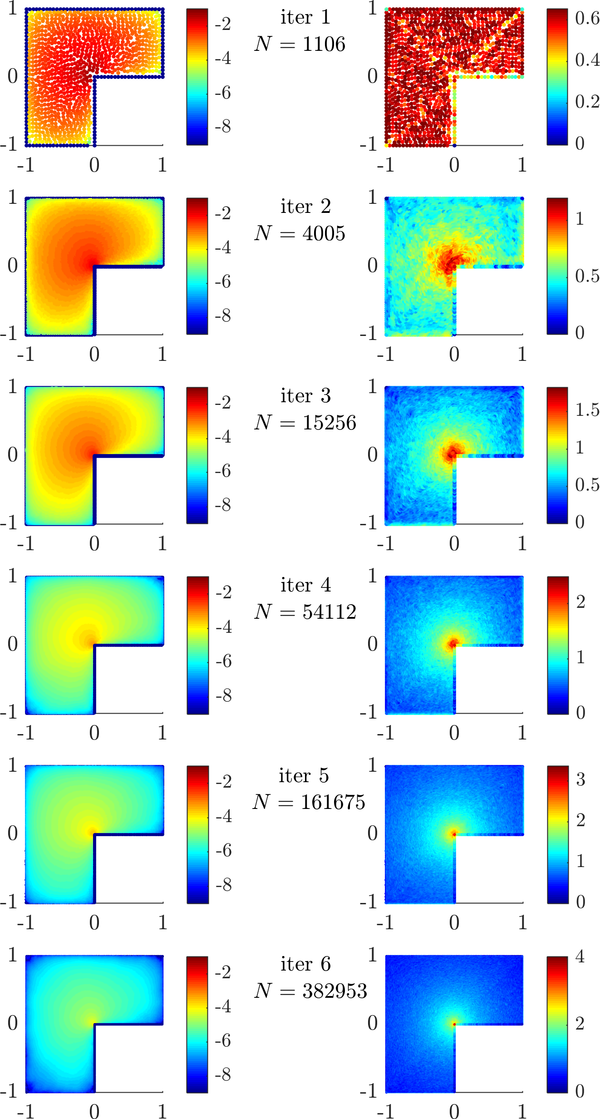Difference between revisions of "Adaptivity"
(→L shaped domain) |
(→L shaped domain) |
||
| Line 58: | Line 58: | ||
BF-FD method with Polyharmonic splines augmented with monomials up to and including 2nd order was used to approximate the differential operators. The stencils for each node were chosen by simply selecting the closest $n=15$ nodes. The resulting sparse system was solved using the Intel ® MKL Pardiso sparse solver. Both uniform and fully adaptive refinement was tested. The adaptive procedure was run with $\alpha=3$, $\varepsilon = 10^-2$, $\beta=1$ and $\eta=0$. | BF-FD method with Polyharmonic splines augmented with monomials up to and including 2nd order was used to approximate the differential operators. The stencils for each node were chosen by simply selecting the closest $n=15$ nodes. The resulting sparse system was solved using the Intel ® MKL Pardiso sparse solver. Both uniform and fully adaptive refinement was tested. The adaptive procedure was run with $\alpha=3$, $\varepsilon = 10^-2$, $\beta=1$ and $\eta=0$. | ||
| − | The errors under uniform and adaptive refinement are shown below. | + | The errors under uniform (left) and adaptive (right) refinement are shown below. |
[[File:L_shape_uniform_error.png|500px]][[File:L_shape_adaptive_error.png|500px]] | [[File:L_shape_uniform_error.png|500px]][[File:L_shape_adaptive_error.png|500px]] | ||
Revision as of 12:52, 11 June 2019
Go back to Examples.
Contents
Basic concept
The adaptive methodology in this paper behaves similarly to "remeshing" used commonly in FEM. Some initial (possibly variable) nodal spacing $h^0$ is chosen, as well as its lower and upper bounds $h_L$ and $h_U$, respectively. 3 Domain $\Omega$ is filled with nodes, conforming to $h^0$ and the solution $u^0$ is obtained. An error indicator is employed to determine which nodes should be (de)refined and the nodal density $h^0$ is altered appropriately. This adaptive cycle below is repeated until the convergence criterion is met. The procedure on $j$-th iteration is written in more detail below:
- Fill $\Omega$ with nodes conforming to $h^j$.
- Solve the problem to obtain $u^j$.
- Compute the error indicator values $\varepsilon_i^j$ for each node $p_i$.
- If the mean of $\varepsilon_i^j$ is below some tolerance $\varepsilon$ return $u^j$ as the solution and stop.
- Adapt $h^j$ to obtain $h^{j+1}$.
More details can be found in our paper: https://arxiv.org/abs/1811.10368
Node density adaptation
The existing nodal spacing function $h^j$ is evaluated at nodes $p_i$ to obtain values $h_{i,j} = h^j(p_i)$ . These values $h_{i,j}$ are modified by a density factor $f_i$ as $$ h_{i,j+1} = \min(\max(h_{i,j} / f_i, h_L(p_i)), h_U(p_i)), $$ where density factor $f_i$ is computed as $$ f_i = \begin{cases} 1 + \frac{\eta - \varepsilon_i}{\eta - m} (\frac{1}{\beta} - 1), & \varepsilon_i \leq \eta, \quad \text{i.e. decrease the density} \\ 1, & \eta < \varepsilon_i < \varepsilon, \quad \text{i.e. no change in density}\\ 1 + \frac{\varepsilon_i - \varepsilon}{M - \varepsilon} (\alpha - 1), & \varepsilon_i \geq \varepsilon, \quad \text{i.e. increase the density} \end{cases} $$ and $\alpha$ represents the refine aggressiveness, $\beta$ the derefine aggressiveness, $\varepsilon$ the refinement threshold, $\eta$ the derenfinement threshold, and $m = \min_i \varepsilon_i$ is the minimal and $M = \max_i \varepsilon_i$ is the maximal value of the error indicator. Note that setting $\alpha=1$ or $\beta=1$ disables refinement and derefinement, respectively.
Error indicators
The work on error indicators is ongoing. For now, we use an ad hoc error indicator $$\varepsilon_i = \operatorname{std}_{j \in I_i}(u_j),$$ which represents the standard deviation of function values over all stencil nodes of a given node $p_i$.
Numerical exmaples
Below are several numerical examples where adaptivity has been tested or used to obtain solutions.
The errors $e_1$, $e_2$, $e_\infty$ and $e_E$ refer to relative discrete $L^1$, $L^2$, $L_\infty$ and energy norm errors, respectively. These are evaluated in the computation nodes or on a denser grid by reinterpolation.
L shaped domain
The L shaped domain problem is defined on $\Omega = [-1, 1]^2 \setminus [0, 1] \times [-1, 0]$. The Laplace problem $$\nabla^2u = 0$ with the solution $u = r^{\frac{2}{3}} \sin(\frac{2}{3}\theta)$ given in polar coordinates. BF-FD method with Polyharmonic splines augmented with monomials up to and including 2nd order was used to approximate the differential operators. The stencils for each node were chosen by simply selecting the closest $n=15$ nodes. The resulting sparse system was solved using the Intel ® MKL Pardiso sparse solver. Both uniform and fully adaptive refinement was tested. The adaptive procedure was run with $\alpha=3$, $\varepsilon = 10^-2$, $\beta=1$ and $\eta=0$.
The errors under uniform (left) and adaptive (right) refinement are shown below.
The error and the nodal density during the adaptive iteration are shown below.
Disk under stress
Hertzian contact
Fretting fatigue contact
Bousinesq problem
Helmholz equation
Go back to Examples.


